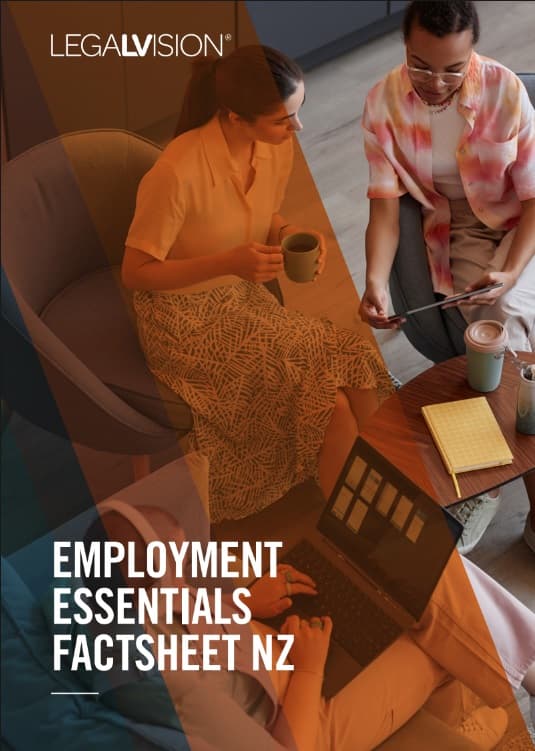In Short
-
Equal Employment Opportunity (EEO) ensures all individuals have fair access to employment based on merit, free from discrimination or harassment.
-
Employers must not discriminate during hiring or employment based on factors like age, race, sex, disability, religion or union involvement.
-
Implementing a comprehensive EEO policy helps prevent discrimination and demonstrates a commitment to a diverse and inclusive workplace.
Tips for Businesses
Develop a clear EEO policy outlining your commitment to fair treatment and diversity. Ensure all hiring practices, workplace behaviours, and employee interactions align with this policy. Regularly train staff to recognise and prevent discrimination, and establish a confidential process for reporting concerns.
Under New Zealand law, you have a responsibility as an employer to prevent and manage discrimination, harassment and bullying of your employees in your workplace. Therefore you must take steps to promote a fair workplace. You can develop an Equal Employment Opportunity (EEO) policy to create a diverse and safe workplace for all your employees. This article explains EEO and what NZ employers should include in an EEO policy.
Your Employer Obligations
Under New Zealand law, you cannot discriminate, directly or indirectly, against your employees. This extends to the hiring process. Here, you cannot ask questions to a job applicant that indicate an intention to discriminate. Some types of discrimination include:
- age;
- race or colour;
- ethnicity or national origins;
- sex (including pregnancy or childbirth);
- sexual orientation;
- disability;
- religious or ethical belief;
- marital or family status;
- employment status;
- political opinion;
- domestic violence victims; and
- involvement in union activities.
As an employer, you are usually responsible for any discrimination, harassment or bullying of employees that occurs in your workplace. If you receive a complaint from one of your employees, you must conduct a full investigation of all the relevant facts. You will minimise your liability if you can show that you took reasonable steps to minimise the issue. You can set out these steps in an Equal Employment Opportunity Policy.

Access this free LegalVision factsheet to ensure you grasp your crucial employment responsibilities.
What Should You Include in an Equal Employment Opportunity Policy?
Just like all workplace policies, it is essential to have a written EEO policy that explains the steps you take to promote a fair workplace and comply with your EEO obligations. Ideally, you should provide the policy to your employees during their onboarding process and provide further training programs to ensure everyone in the workplace understands their obligations. You should review and update your policy regularly to reflect changes to the legislation or your organisation’s culture.
When drafting an EEO policy, you should clearly explain:
- who and when your policy applies, for example, employee types, work locations and processes;
- how your company meets your obligations under the relevant anti-discrimination laws;
- who is responsible for each EEO-related process (for example, if a manager does not resolve an initial complaint, a Human Resources representative can step in);
- details of your hiring process (for example, based on merit and without regard to attributes such as race, sex or gender);
- information on the dismissal of employees without breaching unfair dismissal laws;
- what steps you take to minimise discrimination, harassment or bullying in your workplace and to manage complaints; and
- which equal employment opportunities are available to employees (for example, equal training opportunities for men and women in the workplace).
Key Takeaways
As an employer, it is crucial to understand and comply with anti-discrimination laws in New Zealand. This includes taking steps to minimise discrimination, harassment or bullying of people that occur in your workplace. It is essential to have a written EEO policy that explains the actions you take to promote a fair workplace and comply with your EEO obligations. For example, your policy should include what steps you take to minimise discrimination, harassment or bullying in your workplace and to manage complaints; and which equal opportunities are available to your employees.
If you are drafting an EEO policy, our experienced employment lawyers can assist as part of our LegalVision membership. For a low monthly fee, you will have unlimited access to lawyers to answer your questions and draft and review your documents. Call us today on 0800 005 570 or visit our membership page.
Frequently Asked Questions
To create a fair and safe workplace, you need to start by building a positive culture within your organisation that promotes respect. You should provide all new employees with a copy of your EEO policy, which sets out your behaviour expectations in the workplace, and provide training and information to managers so that they can deal sensitively and appropriately with any complaints.
By encouraging EEO, you can attract more diverse talent, improve your employees’ productivity and promote a positive workplace culture that is free from intimidation and inappropriate behaviour. You will also minimise your liability in the event of a complaint from an employee, which could escalate to an external party such as the New Zealand Police or the Human Rights Commission.
We appreciate your feedback – your submission has been successfully received.












